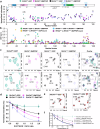Tumor-derived RHOA mutants interact with effectors in the GDP-bound state
- PMID: 39169042
- PMCID: PMC11339415
- DOI: 10.1038/s41467-024-51445-z
Tumor-derived RHOA mutants interact with effectors in the GDP-bound state
Abstract
RHOA mutations are found at diverse residues in various cancer types, implying mutation- and cell-specific mechanisms of tumorigenesis. Here, we focus on the underlying mechanisms of two gain-of-function RHOA mutations, A161P and A161V, identified in adult T-cell leukemia/lymphoma. We find that RHOAA161P and RHOAA161V are both fast-cycling mutants with increased guanine nucleotide dissociation/association rates compared with RHOAWT and show reduced GTP-hydrolysis activity. Crystal structures reveal an altered nucleotide association in RHOAA161P and an open nucleotide pocket in RHOAA161V. Both mutations perturb the dynamic properties of RHOA switch regions and shift the conformational landscape important for RHOA activity, as shown by 31P NMR and molecular dynamics simulations. Interestingly, RHOAA161P and RHOAA161V can interact with effectors in the GDP-bound state. 1H-15N HSQC NMR spectra support the existence of an active population in RHOAA161V-GDP. The distinct interaction mechanisms resulting from the mutations likely favor an RHOAWT-like "ON" conformation, endowing GDP-bound state effector binding activity.
© 2024. The Author(s).
Conflict of interest statement
The authors declare no competing interests.
Figures





Similar articles
-
Structure of an inactive conformation of GTP-bound RhoA GTPase.Structure. 2021 Jun 3;29(6):553-563.e5. doi: 10.1016/j.str.2020.12.015. Epub 2021 Jan 25. Structure. 2021. PMID: 33497604 Free PMC article.
-
An open conformation of switch I revealed by the crystal structure of a Mg2+-free form of RHOA complexed with GDP. Implications for the GDP/GTP exchange mechanism.J Biol Chem. 2000 Jun 16;275(24):18311-7. doi: 10.1074/jbc.M910274199. J Biol Chem. 2000. PMID: 10748207
-
Variegated RHOA mutations in adult T-cell leukemia/lymphoma.Blood. 2016 Feb 4;127(5):596-604. doi: 10.1182/blood-2015-06-644948. Epub 2015 Nov 16. Blood. 2016. PMID: 26574607 Free PMC article.
-
G17V RHOA: Genetic evidence of GTP-unbound RHOA playing a role in tumorigenesis in T cells.Small GTPases. 2015;6(2):100-3. doi: 10.4161/21541248.2014.988088. Epub 2015 Jun 23. Small GTPases. 2015. PMID: 26103434 Free PMC article. Review.
-
The guanine nucleotide-binding switch in three dimensions.Science. 2001 Nov 9;294(5545):1299-304. doi: 10.1126/science.1062023. Science. 2001. PMID: 11701921 Review.
Cited by
-
Structural Dynamics of Rho GTPases.J Mol Biol. 2025 Feb 1;437(3):168919. doi: 10.1016/j.jmb.2024.168919. Epub 2024 Dec 19. J Mol Biol. 2025. PMID: 39708912 Review.
-
Allosteric modulation of NF1 GAP: Differential distributions of catalytically competent populations in loss-of-function and gain-of-function mutants.Protein Sci. 2025 Feb;34(2):e70042. doi: 10.1002/pro.70042. Protein Sci. 2025. PMID: 39840811 Free PMC article.
References
MeSH terms
Substances
Grants and funding
LinkOut - more resources
Full Text Sources
Miscellaneous

